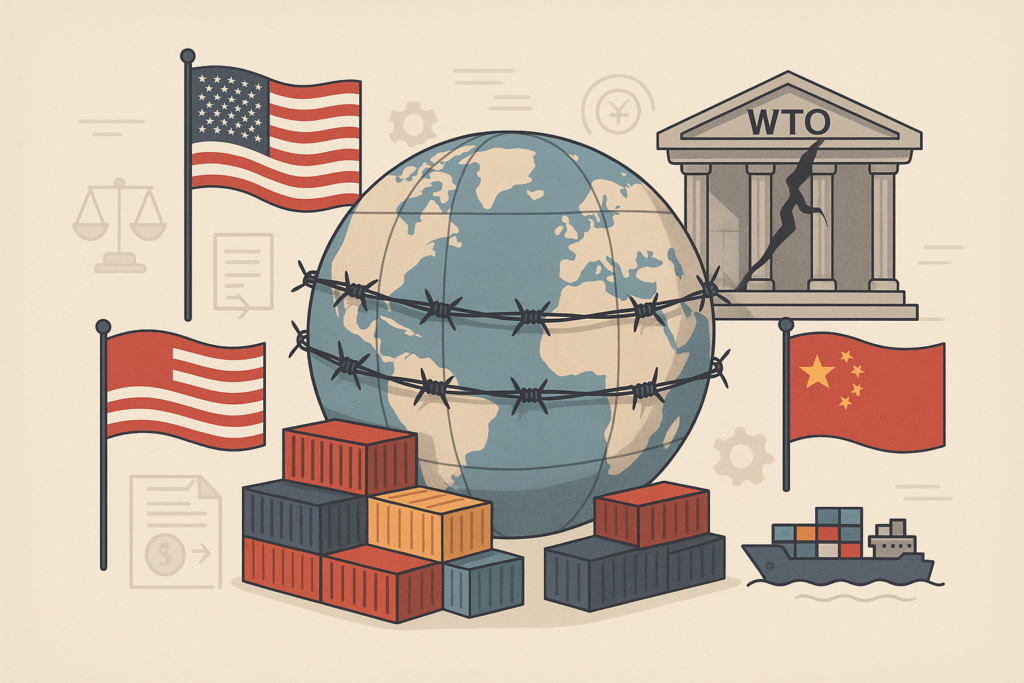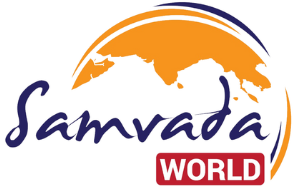
- The WTO’s dispute settlement mechanism is often described as the “Crown Jewel” and is considered one of the most efficient mechanisms in the world.
- U.S. reciprocal tariffs and China’s retaliatory measures violate GATT Article I (MFN) and Article II (bound rates), undermining the WTO’s legal authority.
- The tariffs are imposed under the International Emergency Economic Powers Act (IEEPA), but their legality is questionable.
- The WTO and the IMF have significant power over trade agreements and regulations, which gives it the ability to have a significant impact on a nation’s economy.
The World Trade Organization (WTO) has been tasked with tariff regulation since its inception in 1995, picking off from where its predecessor, the General Agreement on Tariffs and Trade (GATT), ended (1947-1994). GATT, established in 1948, was responsible for tariff reduction, and several rounds of negotiations have occurred to address the same. The Kennedy Round (1964-1967) resulted in an average drop of 35% tariffs on manufactured goods; the Tokyo Round (1973-1979) developed measures concerning non-tariff barriers; while the Uruguay Round (1986-1994) proved to be the greatest, resulting to further reduce tariffs on goods and ultimately culminating in the WTO.
Regulation of tariffs took a new turn after the establishment of the WTO in 1995. The other area that was newly introduced was the Agreement on Agriculture to reduce agricultural trade barriers. One of its early results was the Information Technology Agreement (1996), which abolished all tariffs among nations on IT products, promoting free trade in the IT sector. The introduction of the Most Favoured Nation Principle and Bound tariffs has also contributed towards promoting fair trade. The Doha Development Round (2001) was initiated to reduce tariffs in agriculture as well as industrial goods, which was achieved later in the Bali round in 2013 (Bali package).
The President of the USA, Donald Trump, recently imposed 25% tariffs on imports from Mexico and Canada, with 10% on Chinese imports, under the International Emergency Economic Powers Act, setting the ground for a much larger trade war. This unanticipated turn towards Protectionism and breach of international trade law stands in an economically integrated world. The functionality of the WTO, responsible for promoting free and fair trade and reduction of tariffs, now stands questionable, with no clear stand being taken by the organisation. Will Trump be able to slip through the cracks from the tariff imposition? What can the WTO potentially do?
The Doha Development Round (2001) was initiated to reduce tariffs in agriculture as well as industrial goods, which was achieved later in the Bali round in 2013 (Bali package).
WTO’s dispute settlement mechanism is often described as the “Crown Jewel” and is considered one of the most efficient mechanisms in the world. But this status is at risk since the time Trump blocked the appointment of 2 judges to the appellate body in 2019, and the body has been nonfunctional for years. Further, the United States decided to slash funding for the Appellate Body’s operations in December 2019. Additionally, it delayed the Appellate Body’s selection process for six open positions. Because a minimum of three members are needed to adjudicate any dispute, the Appellate Body is left with just one member, who will be unable to issue any rulings on ongoing trade disputes. Hence, it is less likely for the WTO to rule out Trump’s tariff imposition as unlawful. Moreover, the argument of WTO favouring developed countries, the balkanisation of trade blocs, long negotiation period further hinder the efficiency of the organisation.
The recent U.S. tariffs under President Donald Trump (2025), imposed U.S. tariffs recently under the International Emergency Economic Powers Act (IEEPA), breach General Agreement on Tariffs and Trade (GATT) Articles I and II, provoking a trade war with China, Canada, and the European Union. The WTO’s relevance is declining due to a motionless Dispute Settlement Mechanism (DSM), U.S. disregard for rules, China’s growing influence, and the surging divide between the developed and the developing.
The WTO’s legal foundation rests on its agreements, which are binding contracts among member states. Key statutes and principles include: General Agreement on Tariffs and Trade (GATT), which is responsible for governing the trade in goods, stressing non-discrimination through the Most-Favoured-Nation (MFN) principle (Article I) and national treatment (Article III). Members are required by the MFN to extend their lowest tariff rates to all WTO members, while national treatment ensures treatment of imported as domestic ones, while, the General Agreement on Trade in Services (GATS) covers services trade, applying MFN and transparency principles (Article II), additionally Agreement on Trade-Related Aspects of Intellectual Property Rights (TRIPS) formulates standards for intellectual property protection, balancing innovation with access (Article 4). A mechanism to resolve trade disputes, though its effectiveness is currently limited by the Appellate Body’s paralysis, according to the Dispute Settlement Understanding (DSU). Also, to ensure that the trade policies comply with the WTO rules, is conducted by the Trade Policy Review Mechanism is conducted periodically, ensuring transparency. But in recent times, it is observed that in the context of trade law and political economy, the WTO is on a losing ground despite its application and relevance in the present-day context. The WTO’s laws (GATT, GATS, TRIPS) govern 87% of global merchandise trade, facilitating a predictable framework. For example, GATT Article II ensures tariff ceilings, while the DSU has handled and resolved over 600 disputes since its establishment in 1995. Smaller nations prefer to rely on these rules to counter unilateral actions by powerful nations like the U.S. or China. But it faces backlash due to the absence of the latest technology in recent times, henceforth failing to address modern issues like e-commerce. As there does not exist any WTO law on data localisation, this leaves members to impose non-tariff barriers (NTBs) unchecked. U.S. reciprocal tariffs and China’s retaliatory measures violate GATT Article I (MFN) and Article II (bound rates), undermining the WTO’s legal authority.
The very recent WTO Law Violations include U.S. Reciprocal Tariffs-The U.S.’s April 2025 tariffs (10–50% on 180 countries, 145% on China) discriminate by targeting specific nations, breaching non-discrimination comes under GATT Article I (MFN) whereas GATT Article II talks about the Tariffs exceeding U.S. bound rates (e.g., 3.3% MFN average), requiring compensation or WTO approval, which the U.S. has not sought and DSU Article 23- where by imposing tariffs without WTO dispute processes, the U.S. violates multilateral resolution rules.
In April 2025, the U.S. announced “reciprocal” tariffs on imports from over 180 countries, ranging from 10% to 50%, with China facing 145%. These tariffs, temporarily reduced to 10% (except for China) for 90 days, aim to address perceived trade imbalances but raise significant issues stating U.S. Claim’s arguing that its low MFN tariff rate (3.3%) compared to partners like China (7.5%), India (17%), or the EU (5%) justifies reciprocal tariffs to level the playing field. Non-tariff barriers (e.g., China’s subsidies, EU’s VAT) are also observed as unfair, whereas critics and economists argue these tariffs are not truly reciprocal, as they are based on trade deficits rather than actual barriers. For example, Vietnam faces a 46% U.S. tariff despite offering to eliminate its 9.4% tariffs, showing the formula’s inconsistency. The tariffs violate MFN (GATT Article I) and bound rate commitments, sparking complaints from China, Canada, and others as they also risk escalating into a global trade war, with retaliatory tariffs (e.g., China’s 125% on U.S. goods) Looking at the Economic Impact- The WTO forecasts a 0.2% decline in global merchandise trade in 2025, therefore worsening to 1.5% if tariffs are fully implemented. U.S. imports from China (textiles, electronics) will drop, while other suppliers (e.g., least-developed countries) may gain. The tariffs are imposed under the International Emergency Economic Powers Act (IEEPA), but their legality is questionable. The U.S. Supreme Court may rule that such broad tariffs exceed presidential authority, as tariff-setting is a congressional power.
The WTO’s legal foundation rests on its agreements, which are binding contracts among member states.
However, the WTO has been criticised over the years by a variety of people, including anthropologists like Marc Edelman and economists like Dani Rodrik and Ha Joon Chang, who contend that the organisation”o nly serves the interests of multinational corporations, undermines local development, penalises poor countries, and is increasing inequality.” They also claim that certain agreements about pharmaceutical and agricultural products have resulted in limited access to food and healthcare, which has led to a significant number of deaths. These conditions are said to be caused by several factors, such as national treatment policies, the most favoured nation rule (MFN), and disregard for the infant industry contention. Those who oppose these policies contend that they not only fail to safeguard developing countries but sometimes even exploit them. For instance, market distortions harm developing nations $700 billion in lost revenue from exports every year, according to UNCTAD estimates. Furthermore, nationalist and conservative opponents of the WTO contend that it jeopardises and erodes national sovereignty. Before the 2019 Appellate Body judge election, this argument gained prominence when US President Trump decided to block the WTO as a means to restore his country’s autonomy.
Thereby, tariffs, while disrupting global trade, are also essential for the protection of vital domestic sectors such as agriculture. The WTO, one of the biggest international economic institutions (alongside the World Bank and the International Monetary Fund (IMF), has significant power over trade agreements and regulations, which gives it the ability to have a significant impact on a nation’s economy. The WTO’s policies are designed to “ensure that trade flows as smoothly, predictably, and freely as possible” while balancing trade liberalisation with tariffs and other economic protection measures. The World Trade Organisation asserts that its initiatives “cut living costs and raise standards, stimulate economic growth and development, help countries develop, and give the weak a stronger voice.” But WTO should actively play a role in effectively enforcing bound tariffs so that free and fair trade is ensured among the countries. Additionally, the developed-developing divide should be addressed to benefit the parties involved in negotiations.
References:
- World Trade Organization. (n.d.). The GATT 1994. https://www.wto.org/english/docs_e/legal_e/06-gatt_e.htm
- World Trade Organization. (n.d.). Understanding the WTO: The agreements. https://www.wto.org/english/thewto_e/whatis_e/tif_e/agrm1_e.htm
- White House. (2025b, April 8). Amendment to reciprocal tariffs and updated duties as applied to low-value imports from the People’s Republic of China. https://www.whitehouse.gov/presidential-actions/amendment-reciprocal-tariffs-updated-duties-applied-low-value-imports-peoples-republic-china/
- White House. (2025c, April 10). Modifying reciprocal tariff rates to reflect trading partner retaliation and alignment. https://www.whitehouse.gov/presidential-actions/modifying-reciprocal-tariff-rates-reflect-trading-partner-retaliation-alignment/
- White House. (2025d, April 3). Fact sheet: President Donald J. Trump declares national emergency to increase our competitive edge, protect our sovereignty, and strengthen our national and economic security. https://www.whitehouse.gov/briefing-room/statements-releases/2025/04/03/fact-sheet-president-donald-j-trump-declares-national-emergency-to-increase-our-competitive-edge-protect-our-sovereignty-and-strengthen-our-national-and-economic-security/
- Business Standard. (2025, April 3). From GATT to WTO: How Trump’s tariffs are pushing global trade rules. https://www.business-standard.com
- Chatham House. (2021, August 2). Lessons from Trump’s assault on the World Trade Organization. https://www.chathamhouse.org
- Parliament UK. (2025, March 12). The geopolitics of trade tariffs: The new Trump presidency. https://commonslibrary.parliament.uk
- Reuters. (2025, April 9). China files new complaint to WTO over Trump tariffs. https://www.reuters.com
- The Guardian. (2025, April 16). Trump tariffs will send global trade into reverse this year, warns WTO. https://www.theguardian.com
- The White House. (2025, April 2). Regulating imports with a reciprocal tariff to rectify trade practices. https://www.whitehouse.gov
- World Trade Organization. (2018, June 21). Understanding the WTO: A unique contribution. https://www.wto.org
- World Trade Organization. (2021, November 15). Understanding the WTO: Principles of the trading system. https://www.wto.org
- World Trade Organization. (2023, January 26). Dispute settlement – DS543: United States — Tariff Measures on Certain Goods from China. https://www.wto.org
Dr. Lakshmi Karlekar is an Assistant Professor at the Department of Humanities – Political Science and International Relations, Ramaiah College of Arts, Science and Commerce, Bengaluru. She holds a PhD in International Studies from CHRIST (Deemed to be) University. Tanishaa Pandey is a BBA LLB student at the School of Law, CHRIST (Deemed to be University), Central Campus, Bengaluru. Views expressed are the author’s own.
